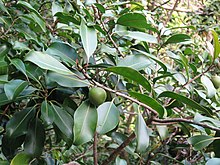Pouteria sandwicensis
| Pouteria sandwicensis | |
|---|---|

| |
| Green fruit and leaves | |
| Scientific classification | |
| Kingdom: | Plantae |
| Clade: | Tracheophytes |
| Clade: | Angiosperms |
| Clade: | Eudicots |
| Clade: | Asterids |
| Order: | Ericales |
| Family: | Sapotaceae |
| Genus: | Pouteria |
| Species: | P. sandwicensis
|
| Binomial name | |
| Pouteria sandwicensis | |
| Synonyms | |
|
Sideroxylon sandwicense (A.Gray) Benth. & Hook.f. | |
Pouteria sandwicensis is a species of flowering tree in the sapodilla family, Sapotaceae, that is endemic to the main islands of Hawaii. Names for this species in the Hawaiian language include ʻĀlaʻa, Āulu and ʻĒlaʻa.[2]
Description[]

ʻĀlaʻa inhabits dry, coastal mesic, and mixed mesic forests at elevations of 240–980 m (790–3,220 ft).[3] ʻĀlaʻa reaches a height of 15 m (49 ft) and a trunk diameter of 0.4 m (1.3 ft). The thick bark is grey and fissured, with an orange inner layer. The leaves are alternate, thick, leathery, oblong or elliptical, and measure 6–14 cm (2.4–5.5 in) long and 3–6 cm (1.2–2.4 in) wide. The upper surfaces of the leaves are glabrous and shiny green, while the lower surfaces are dull and may feature bronze or reddish brown pressed hairs. The hairs are sometimes found only on the tips of new leaves (see photo gallery below). Inflorescences with one to four bell-shaped flowers are found at the bases of leaves. The fruit, a berry, is 3–4 cm (1.2–1.6 in) in diameter and yellow, orange, or purplish black. Each fruit contains one to five seeds, which are about 2 cm (0.79 in) long and yellow brown.[1]
Uses[]
The wood of ʻālaʻa is yellow with black streaks, extremely hard, and close grained.[1] Native Hawaiians used it in house construction and to make the pale (gunwales) of waʻa (outrigger canoes),[3] ʻōʻō (digging sticks), and ihe (spears). The sticky, milky sap was used as a kolū (glue) for weapon and tool handles[2] and as kēpau (birdlime), much like papala kepau (Pisonia spp.).[4]

References[]
- ^ Jump up to: a b c Little Jr., Elbert L.; Roger G. Skolmen (1989). "ʻĀlaʻa" (PDF). United States Forest Service. Cite journal requires
|journal=(help) - ^ Jump up to: a b Medeiros, A. C.; C.F. Davenport; C.G. Chimera (1998). "Auwahi: Ethnobotany of a Hawaiian Dryland Forest" (PDF). Cooperative National Park Resources Studies Unit, University of Hawaiʻi at Mānoa: 17–18. Cite journal requires
|journal=(help) - ^ Jump up to: a b "'ala'a, aulu, elaa, kaulu". Hawaiian Ethnobotany Online Database. Bernice P. Bishop Museum. Archived from the original on 2007-07-02. Retrieved 2009-11-14.
- ^ Barboza, Rick (2009-04-03). "Beautiful native tree varies in appearance". Honolulu Star-Bulletin.
External links[]
![]() Media related to Planchonella sandwicensis at Wikimedia Commons
Media related to Planchonella sandwicensis at Wikimedia Commons
![]() Data related to Pouteria sandwicensis at Wikispecies
Data related to Pouteria sandwicensis at Wikispecies
- Pouteria
- Endemic flora of Hawaii
- Trees of Hawaii
